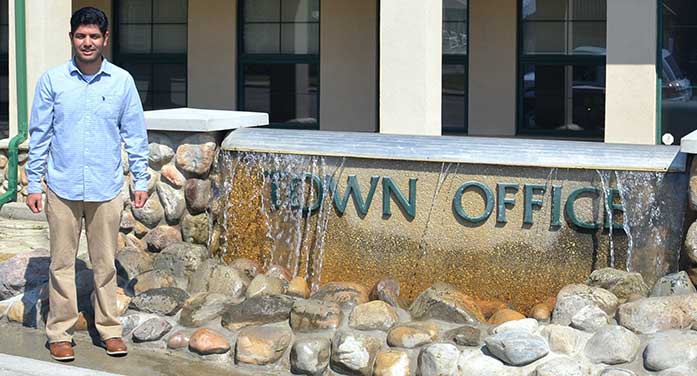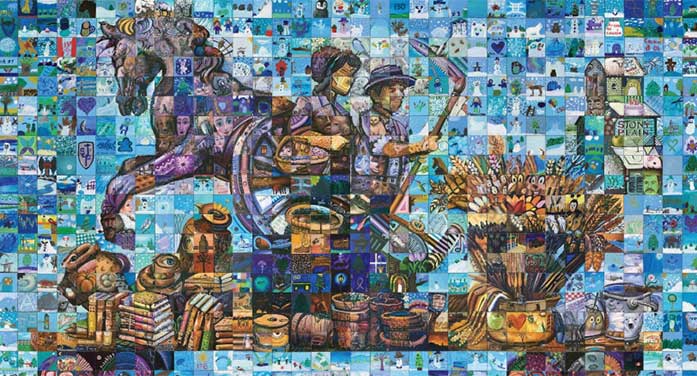Pitching a plan to a municipal government isn’t usually on the learning curve for a university student, but that didn’t dim Nicklas Baran’s excitement as he presented his work to the Town of Stony Plain this summer.
“It made me feel great, like an expert who has great in-depth knowledge of some mysterious topic.”
That “mysterious topic” took the form of two comprehensive documents for the municipality of 18,000 people west of Edmonton, outlining the community’s environmental features and making recommendations on how to preserve them as the town grows.
As an intern with the University of Alberta’s Sustainability Scholars program, Baran was hired by the town to help develop an environmental master plan and an environmental stewardship strategy for the community.
The program, run through the U of A’s Sustainability Council, helps graduate students develop their professional aptitudes in sustainability-related career fields.
The master’s student in the School of Urban and Regional Planning in the Faculty of Science said he found the presentation to council – the sum total of his work – invaluable to his career goal of becoming a registered professional planner.
“While I have experience presenting to fellow students, researchers and professors, presenting to seven elected officials making a decision on whether my work is of merit is completely different. I’d guess a vast majority of urban planning students have never done that, and it will go a long way for my career.”
Baran, whose degree research focuses on the dynamics of decision-making around innovative urban drainage systems, continued work started on the town’s environmental plan in 2020 by a previous student in the Sustainability Scholars program.
Working closely with several Stony Plain town staff, he conducted a public survey, analyzed the resulting data and researched environmental initiatives, then finalized the environmental master plan and created a detailed report for the stewardship strategy.
Baran is excited about the cutting-edge features the plan offers – tailored to the town’s specific needs while affording flexibility in achieving goals.

Nicklas Baran stands in front of the Stony Plain Town Office. The master’s student in urban planning spent a summer internship helping the town develop a comprehensive environmental master plan and stewardship strategy. (Photo: Supplied)
“We worked hard to make these documents unique to Stony Plain. It’s easy to put together a generic document, but customizing a master plan specific to the community is instrumental in assuring its success because no community’s ecosystem is like another.”
And while most municipalities have just one broad policy and action document addressing their environmental plan, that usually requires frequent adjustment, Baran noted. Stony Plain’s plan is broken into two parts, one outlining policies that aren’t expected to change and the other listing specific actions.
“It allows the town to be more deliberate with its new initiatives.”
The plan also proposes a five-phase approach to bringing in environmental initiatives, instead of the usual practice of pinning it to set timelines such as a five-year plan, for example. This lets the community tailor its available resources to meeting its goals.
“The documents accepted by council are certainly some of the most forward-thinking in the Edmonton metropolitan region, even in Alberta,” Baran said, noting that other municipalities could look to the framework as well.
“If a community has too broad or too specific a master plan, they can look to the Stony Plain model, which has two separate documents to mitigate the issue.”
Baran’s work “has given council the framework to prioritize its environmental goals,” said Miles Dibble, manager of planning and development for the Town of Stony Plain.
The involvement of U of A scholars like Baran brings a fresh perspective to the table, he added.
“A graduate student who is learning the newest information has the ability to ask new questions and look at things from a different angle. It makes the project much more comprehensive and holistic.”
Instead of limiting his comparison of the town’s plan to others in the region, for example, Baran also looked at those in other parts of Canada. “It challenged existing ways of doing things,” Dibble said.
Baran’s presentation to council was well-received, Dibble added.
“They had an appreciation for the material and for someone like Nicklas, as a graduate student who is an expert in his academic field, to present it.”
Baran was glad to take his expertise as a researcher into the public arena.
“It was rewarding simply knowing the work I put into this project will actually have impact on the ground, that it will benefit a community and its ecosystem.”
Baran’s work was funded in part by the U of A’s Graduate Student Internship Program, which allows students to incorporate work-integrated learning experiences into their graduate studies.
| By Bev Betkowski
This article was submitted by the University of Alberta’s Folio online magazine. The University of Alberta is a Troy Media Editorial Content Provider Partner.
© Troy Media
Troy Media is an editorial content provider to media outlets and its own hosted community news outlets across Canada.


